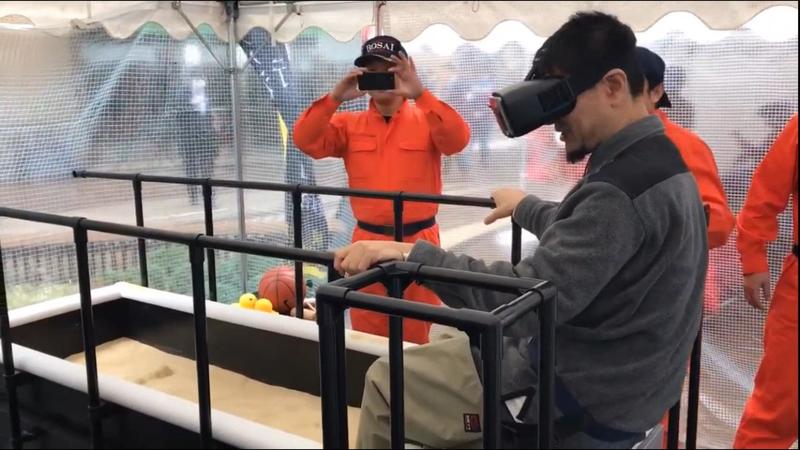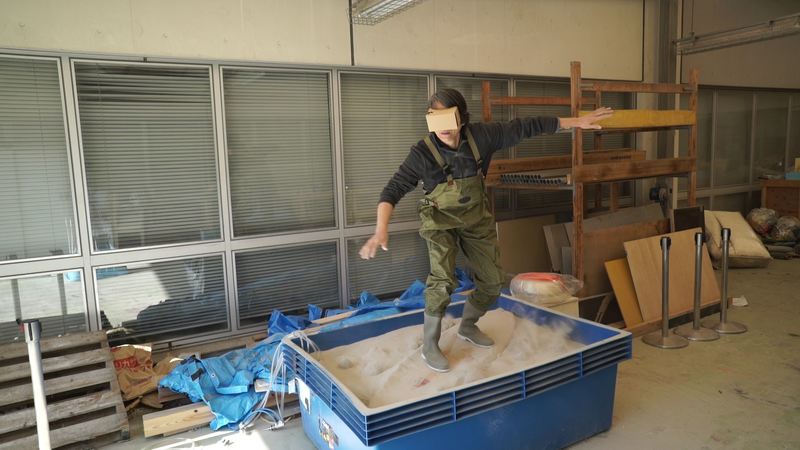Interviews

Instant Liquefaction with the Fluidized Bed Interface (Part 3)
Yasushi Matoba
Once the challenge within the INNO-vation Program had passed, what direction did the Fluidized Bed take?
Interviewer & Japanese Writer: Yamamoto Takaya; Translation & Editing: Matthew Cherry
Yasushi Matoba’s Fluidized Bed Interface is a device chock-full of all kinds of applications. Even after his time in the INNO-vation Program had ended, the pursuit for more possibilities continued. One of those possibilities was a simulated natural disaster experience.
(Part 1 of our interview covers the concept of the Fluidized Bed Interface, and Part 2 details its possibilities.)
Combining the Fluidized Bed Interface with simulated AR technology developed by Tomoki Itamiya, Ph.D., (then Associate Professor at Aichi University of Technology), Matoba created equipment that allowed users to experience simulated flooding. The equipment was featured at the Hibiya Experiential Disaster Drills Event, held in 2019 at Tokyo Midtown Hibiya, Japan.
With the Fluidized Bed Interface, air is introduced into the bottom of a bed of sand, causing the sand itself to behave like a liquid. Walking inside of the sand can be made more cumbersome by adjusting the airflow. Reducing the airflow makes it difficult to walk, and cutting it off completely will stop someone in their tracks, as if they’ve become stuck in the mud.
“A flood isn’t really something anyone can experience until it actually happens, but by using AR technology to overlay images of a flood while walking through the Fluidized Bed Interface, it’s possible to get up close with a fairly realistic simulation. You can get a sense of what it’s like to have your feet held back by the water and understand just how frightening floods truly are,” Matoba explains.

Simulated Flood Experience Combined with AR
It goes without saying that entertainment value continues to be a particular matter of interest for Matoba. His more recent works include using the interface to project various changing patterns and colors corresponding to the movements of a toy sword thrust into the sand. This invention proved popular with children, their eyes lighting up as they watched the projected images change based on their own movements.

The Interface Combined with Projection Mapping
Matoba spoke about his dreams. “Because the Fluidized Bed Interface contains so many possibilities inside of it, there’s potential for a lot of amusing entertainment applications. Ideally, I’d like to make the device applicable to theme parks, concerts, and theater performances.”

Simulated Surfing Experience using VR Goggles
The driving force behind Matoba’s developments is the burning desire to create something that the world has never seen before. But creating something is just one step. Getting the world to understand and accept something new can prove to be quite the challenge. At the beginning of the Fluidized Bed Interface’s development, Matoba approached a university he was familiar with for joint research, but he was ultimately unable to find any students that would work with him on the project.
The AquaTop Display wasn’t initially well-received, either. When presented with the touch panel displayed on the surface of bathwater, many people told him that wasn’t what a bath was supposed to be used for. But it was Matoba who had the last laugh when it went on to receive high praise and win multiple awards, including the Grand Prix at Laval Virtual 2013 in France.
“Whether it’s a company or a university, the tendency for an unusual idea to be initially rejected is pretty high, perhaps even more so in Japan. I don’t think that initial rejection is completely unhelpful, rather there’s a good theme about it hidden buried underneath. If you take a look at the projects selected by the INNO-vation Program, many of them have that same unique quality that might be rejected by society from the outset. I encourage anyone to take on this challenge without fear of failure, as it just may be a chance to finally have a good idea recognized for what it is.”
Yasushi Matoba, currently a guest professor at The Institute of Technologists, is looking forward to seeing what both he and society can bring to the world with the next never-before-seen creations, ideas, and technologies.
Yasushi Matoba’s Profile

